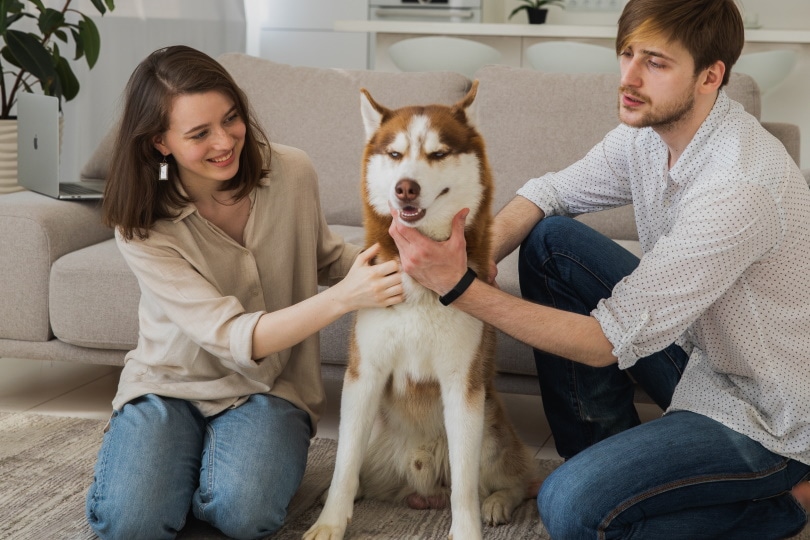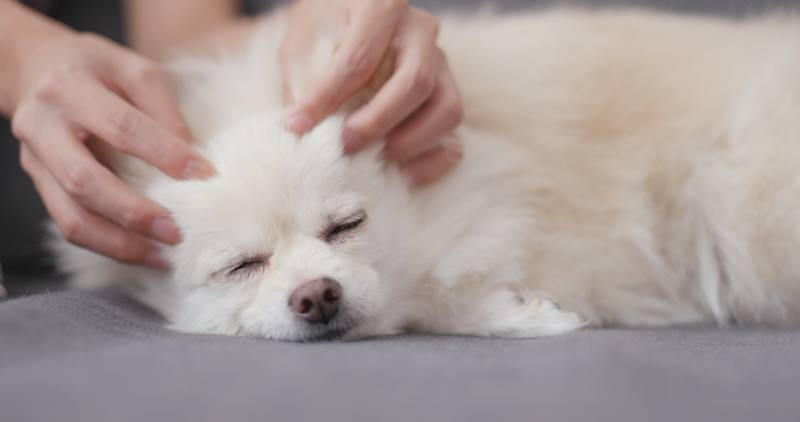The bliss and relaxation that follow a massage are unforgettable, but massages have more to offer than just relaxation, and it’s the same for our dogs. Dog massage is not a gimmick; your beloved pet can enjoy both the physical and mental benefits of a gentle rub. The great thing is that you can easily do it at home, and your dog will be so grateful. It is also a great way to bond and show your dog affection. In this article, we’ll discuss the benefits your dog can enjoy from a simple massage.
The 7 Great Benefits of Massaging Your Dog
1. Reduces Stress and Anxiety

Just as massage can reduce stress and anxiety in humans, it can do the same for your pup, especially if they are easily stressed out. The primary causes of anxiety in dogs are fear, confusion, and separation. By incorporating massage into your dog’s routine, you can help them stay relaxed, reassure them, and comfort them.
Three acupressure points on the head and face are especially helpful for stress and anxiety. The Yin Tang point can be considered your pet’s “third eye,” found in the center of the forehead, between and a little above the eyes. Yang Tang points can be found on either side of the eyes, where you would consider your dog’s temples to be. The spots are linked to general well-being, calm, and focus, and pets usually nod off to sleep when these points are massaged.
2. Improves Circulation and Lymphatic Flow
Healthy circulation ensures a healthy supply of oxygen, nutrients, and blood, which is vital for their skin and coat and overall health. Pressure through massage can bring a fresh supply of oxygenated blood to specific areas, relieving swelling and tension and helping your dog relax.
Lymph is a clear fluid that circulates through the lymphatic system and is a component of the immune system. Swelling and discomfort can occur when lymph does not flow properly between tissues and lymph nodes. Massage improves the flow of lymph fluid and aids in the removal of metabolic waste from your dog’s muscles and internal organs.
3. Relieves Joint Pain and Arthritis

When your dog is being massaged, endorphins are released, which can assist with relieving pain. An active dog that enjoys running and swimming can easily exert itself, resulting in stiff and sore muscles. A massage will help reduce the tension by relaxing the muscles. In the same way that massage helps aching muscles and joints, it can be beneficial for dogs suffering from arthritis.
Arthritis is commonly caused by aging, developmental disorders, and injuries. As your dog gets older, arthritis can become more painful and uncomfortable, which makes treatment a top priority.
4. Strengthens the Immune System
As we mentioned before, massaging your dog will encourage relaxation by reducing stress hormones. This improves health, which leads to a strengthened immune system. Because massage improves circulation, it enhances the circulation of white blood cells and the production of white blood cells that fight infection.
A robust immune system is essential to the health and well-being of your pup, so it’s worth incorporating a massage routine in your dog’s daily activities.
5. Assists in the Recovery Process
If your dog is recovering from an injury or being rehabilitated from surgery, massage can assist the process. Massage will help the injured area and the rest of the body that is taking the extra strain. If your dog is recovering from surgery, your vet can help you with the best techniques to assist in your dog’s recovery.
PangoVet. It’s an online service where you can <b>talk to a vet online</b> and get the personalized advice you need for your pet — all at an affordable price!
</p>
<div class="su-button-center"><a href=https://www.dogster.com/dog-health-care/"https://pangovet.com/?utm_source=dogster&utm_medium=article&utm_campaign=dog_preventative_wellness%22 class="su-button su-button-style-default" style="color:#FFFFFF;background-color:#FF6600;border-color:#cc5200;border-radius:9px;-moz-border-radius:9px;-webkit-border-radius:9px" target="_blank" rel="nofollow"><span style="color:#FFFFFF;padding:0px 24px;font-size:18px;line-height:36px;border-color:#ff944d;border-radius:9px;-moz-border-radius:9px;-webkit-border-radius:9px;text-shadow:none;-moz-text-shadow:none;-webkit-text-shadow:none"> Click to Speak With a Vet</span></a></div></div></div>"}" data-sheets-userformat="{"2":513,"3":{"1":0},"12":0}" data-sheets-validation-definition="{"1":{"1":{"1":23,"2":[{"1":1,"3":{"1":{"1":[{"1":4,"6":1},{"1":1,"2":"="}]},"2":{"1":[{"1":2,"2":"="},{"1":3,"3":1}]},"3":"R1]S"},"4":[{"1":{"1":0,"2":20,"3":0,"4":1,"5":2236944,"6":"841046713"},"2":1}]}],"6":[{"1":{"2":{"1":2,"2":"❤️ Preventative wellness"}},"2":{"1":2,"2":676776},"3":{"1":2,"2":12574966}},{"1":{"2":{"1":2,"2":"🤮 Vomiting"}},"2":{"1":2,"2":676776},"3":{"1":2,"2":12574966}},{"1":{"2":{"1":2,"2":"🛡️ Flea & tick"}},"2":{"1":2,"2":676776},"3":{"1":2,"2":12574966}},{"1":{"2":{"1":2,"2":"🍎 Ate or drank"}},"2":{"1":2,"2":676776},"3":{"1":2,"2":12574966}},{"1":{"2":{"1":2,"2":"🐕 Behavior & training"}},"2":{"1":2,"2":676776},"3":{"1":2,"2":12574966}},{"1":{"2":{"1":2,"2":"👁️ Eye issues"}},"2":{"1":2,"2":676776},"3":{"1":2,"2":12574966}},{"1":{"2":{"1":2,"2":"⚠️ Urinary problems"}},"2":{"1":2,"2":676776},"3":{"1":2,"2":12574966}},{"1":{"2":{"1":2,"2":"🩺 Other"}},"2":{"1":2,"2":676776},"3":{"1":2,"2":12574966}}]},"2":{"1":{"1":[{"1":4,"6":0},{"1":4,"6":1},{"1":2,"3":"CONDITION_ONE_OF_RANGE","4":2},{"1":1,"2":"="}]},"3":"R0]R1]FCONDITION_ONE_OF_RANGE:2]S"},"3":[{"1":{"1":0,"2":1,"3":0,"4":1,"5":1118464},"2":0},{"1":{"1":0,"2":20,"3":0,"4":1,"5":2236944,"6":"841046713"},"2":1}]},"2":"","3":1,"4":1,"6":0}" data-sheets-validation-id="0"> If you need to speak with a vet but can’t get to one, head over to PangoVet. It’s an online service where you can talk to a vet online and get the personalized advice you need for your pet — all at an affordable price!

6. Helps to Identify Potential Health Issues
An important benefit of incorporating a regular massage routine for your dog is that you will become familiar with its body and will easily recognize if something is out of the ordinary or has changed. You can locate troubling growths or injuries early and get your dog to the vet for a diagnosis and correct care.
During the massaging process, be aware of lumps and swelling and take note of the surface temperature of your dog’s skin. Massage can help in the early detection of medical conditions, which can help prolong your dog’s life while giving you peace of mind that your pup is healthy.

Reflexology
While massage has been proven beneficial for dogs, there is still no conclusion for reflexology. Reflexology is a massage technique based on the reflex points in the feet. By massaging those points, which are linked to the rest of the body, tension is said to be released, and medical conditions are eased, but so far, there are no studies on how this affects pets.
The most common type of reflexology involves applying pressure to various areas of the bottom of the dog’s foot. Reflexology can reduce stress, encourage relaxation, increase energy, promote circulation, and relieve aches and pain.
Some dogs dislike having their paws touched, and some may be resistant to reflexology. You should never force your dog and stop if they show signs of discomfort. A serious illness or injury requires veterinary diagnosis and treatment and should not be treated with reflexology. It may be difficult to locate a reflexology practitioner for your dog, but you can try some reflexology techniques on your own. If nothing else, it’s a fun way to bond with your dog.
3 Massaging Techniques You Can Do at Home
While your dog can be massaged in many ways, there are three main techniques that you can use at home.
1. Massage for Stress Relief

If your dog is stressed or anxious, slow and gentle movements are essential to help them transition into a calmer state. Using soft strokes, start at the neck and work downward. Keep a steady and consistent flow, and try to determine where your dog feels tense. As the massage continues, you will notice your dog’s body relaxing, and your dog may drift off to sleep.
2. Massage for Pain
Start this technique the same way you would use the stress massage technique and slowly introduce compression and pumping motions. These movements will soften the tense tissues and muscles, allowing them to relax and untwist. Be extra careful and work more gently on the areas where there is pain, finishing the massage with gentle stroking and petting.
3. Massage for Injury Rehabilitation
If your dog is recovering from an injury, the technique you use will depend on the type of injury. Typically, your vet will demonstrate some methods for a proper recovery. Massages for rehabilitation should only be performed if cleared by your vet, but they generally involve gentle motion exercises. Before you start the recovery technique, you can gently stroke your dog to help put it in a calm and relaxed state.
If your pet enjoys being groomed, you can incorporate brushing or combing into the massage. Your dog may drool, groan, or even fall asleep if they enjoy your gentle touch. Gentle massage can be done as needed, but more intensive massages should be reserved for special occasions.
Summary
Canine massage can provide many health benefits for your beloved pet, but most importantly, your dog will feel content and relaxed. You can incorporate a gentle massage routine to help with any anxiety or stress, and it will benefit you both by strengthening your bond.
A bit more pressure can be added to your technique if your dog is experiencing sore muscles after an active day, but if your dog has a severe injury or medical condition, it’s probably best to seek a professional.
Featured Image Credit: Rasulov, Shutterstock
Contents
- The 7 Great Benefits of Massaging Your Dog
- 1. Reduces Stress and Anxiety
- 2. Improves Circulation and Lymphatic Flow
- 3. Relieves Joint Pain and Arthritis
- 4. Strengthens the Immune System
- 5. Assists in the Recovery Process
- 6. Helps to Identify Potential Health Issues
- Reflexology
- 3 Massaging Techniques You Can Do at Home
- Summary











